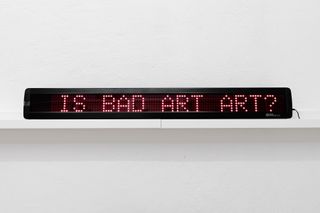Is Bad Art Art? Is Bad Art Bad?
Video recording of working installation
Medium: Video (color, no sound)
Duration: 3:27 min.
Medium: ticker display.
Is Bad Art Art? Is Bad Art Bad? (2015) is an installation consisting of a ticker display.
It was exhibited at Wyszło jak wyszło [Epic Fail] exhibition in Klubojadalnia Eufemia. Wyszło jak wyszło [Epic Fail] was an exhibition of works by Przemysław Kwiek, Monika Proniewska, Piotr Bekas and Maciej Ratajski, relating to the notions of failure and weakness.
At the exhibition, the work was accompanied by a gibberish curatorial text compiled from fragments of captions found in the Museum of Contemporary Art in Kraków:
A general reflection on human existence. The dominant black in the composition draws into some abyss, symbolizing — perhaps — the proportions of human existential consciousness. The artist seems to be searching for the symbolism of fate in the abstract chaos that we create around ourselves. This approach allows for various metaphysical speculations and exudes existential metaphoricality. The uniqueness of the human being confirmed by an artistic document which, unlike other identity documents, does not dehumanize or turn into an “anonymous” element of the system. The composition — “violated” by the speed of the inscription — is forced to get closer. Strongly moving act imposes a high level of loudness on the symbols. Someone not afraid of banality could say: “as in life”.
Wersja polska:
Ogólna refleksja na temat ludzkiej egzystencji. Dominująca w kompozycji czerń wciąga w jakąś otchłań, symbolizując — być może — proporcje ludzkiej egzystencjalnej przytomności. Artysta wydaje się poszukiwać symboliki losu w abstrakcyjnym chaosie, który wytwarzamy wokół siebie. Takie postawienie problemu pozwala na różne spekulacje metafizyczne i emanuje egzystencjalną metaforycznością. Niepowtarzalność człowieka potwierdzona przez dokument artystyczny, który w przeciwieństwie do innych dokumentów tożsamości nie dehumanizuje i nie zamienia w „anonimowy” element systemu. Kompozycja — „zgwałcona” prędkością napisu — zostaje zmuszona do odpowiedniego zbliżenia. Akt silnie poruszający narzuca symbolom wysoki poziom nagłośnienia. Ktoś nieobawiający się banału mógłby powiedzieć: „jak w życiu”.

![Is Bad Art Art? Is Bad Art Bad? (2015) Installation view at Klubojadalnia Eufemia during Wyszło jak wyszło [Epic Fail] exhibition (2015).](/img/maciej-ratajski-2015-05-22-wyszlo-jak-wyszlo-is-bad-art-art-320.jpeg)